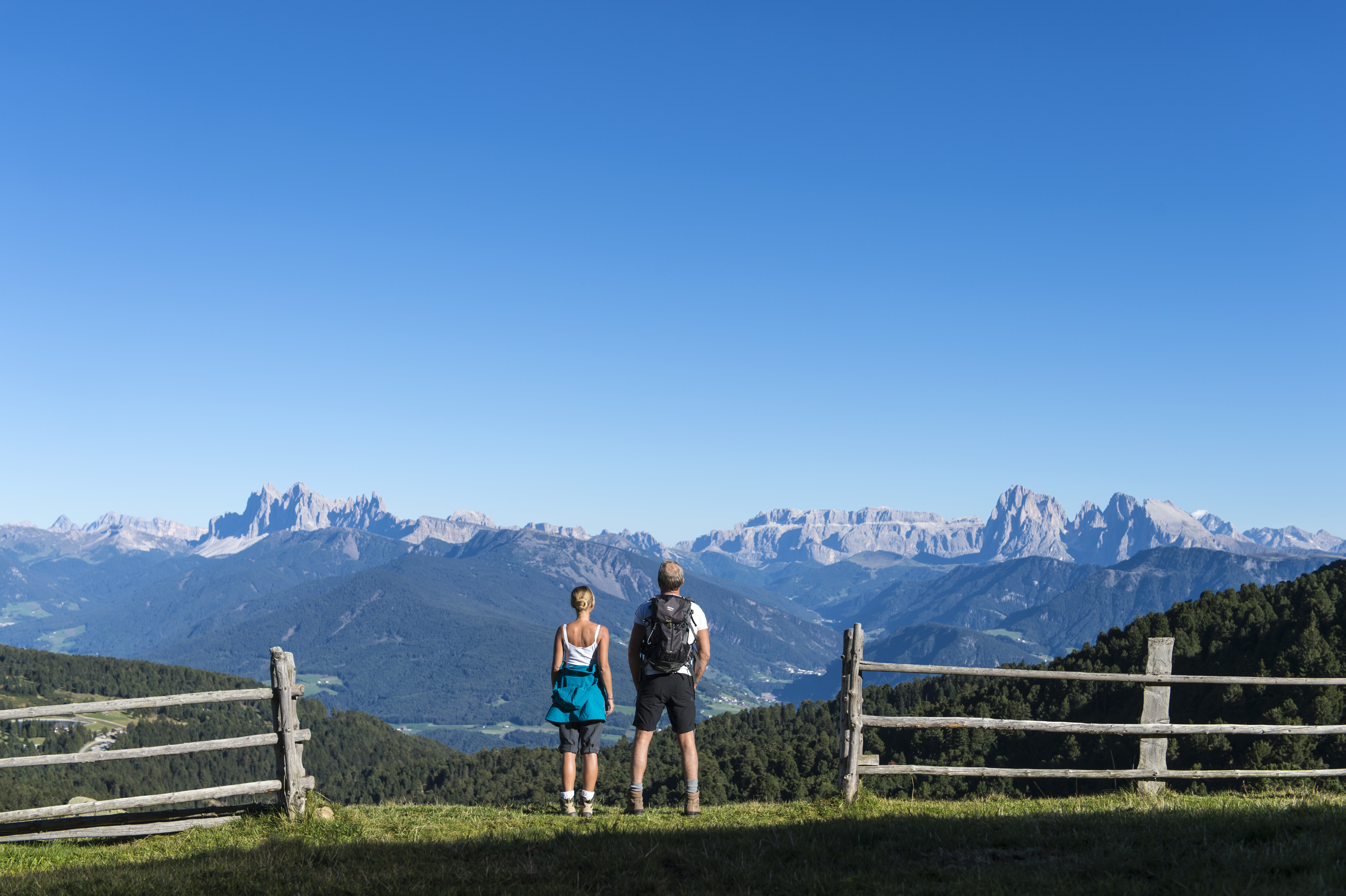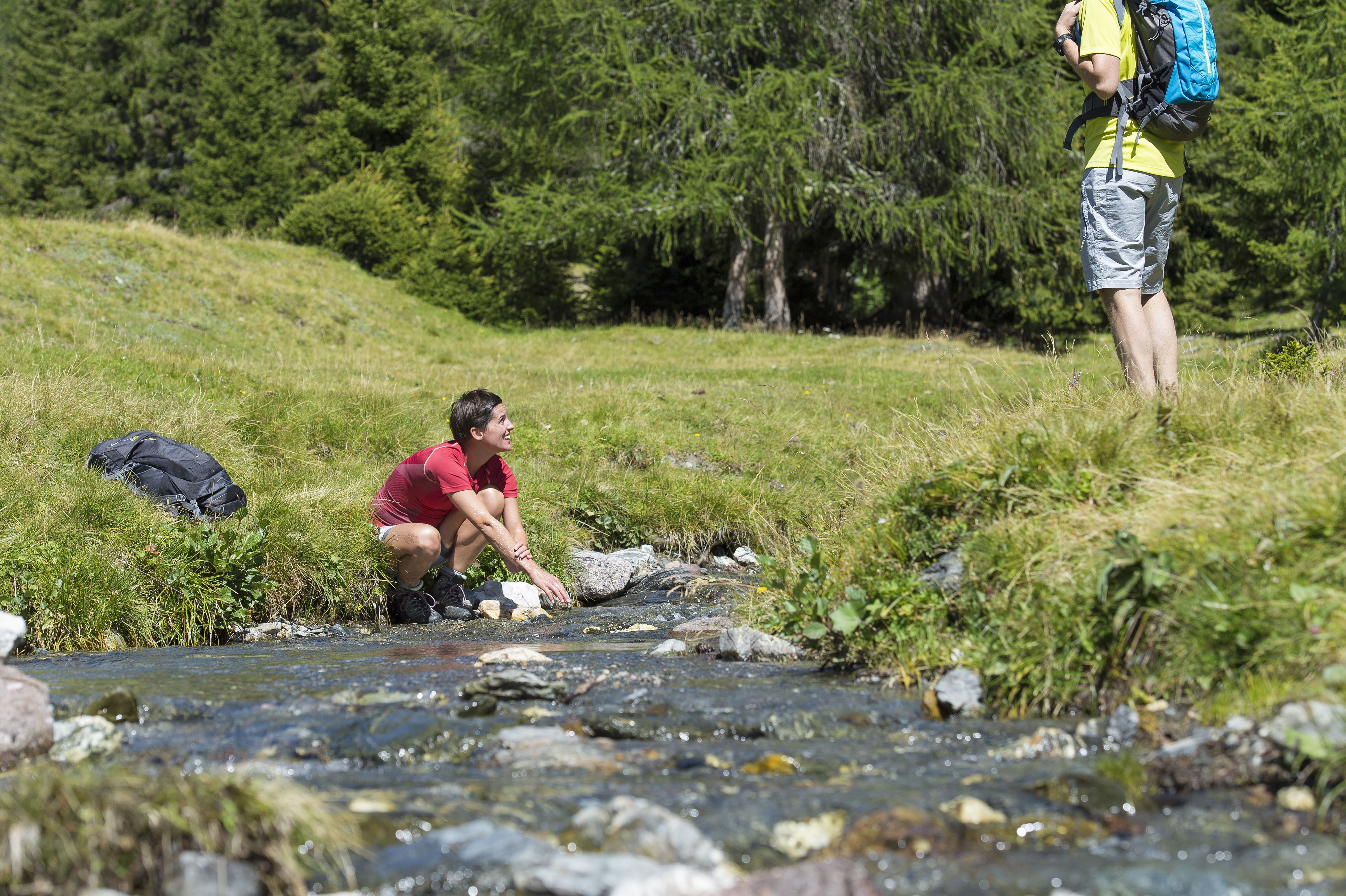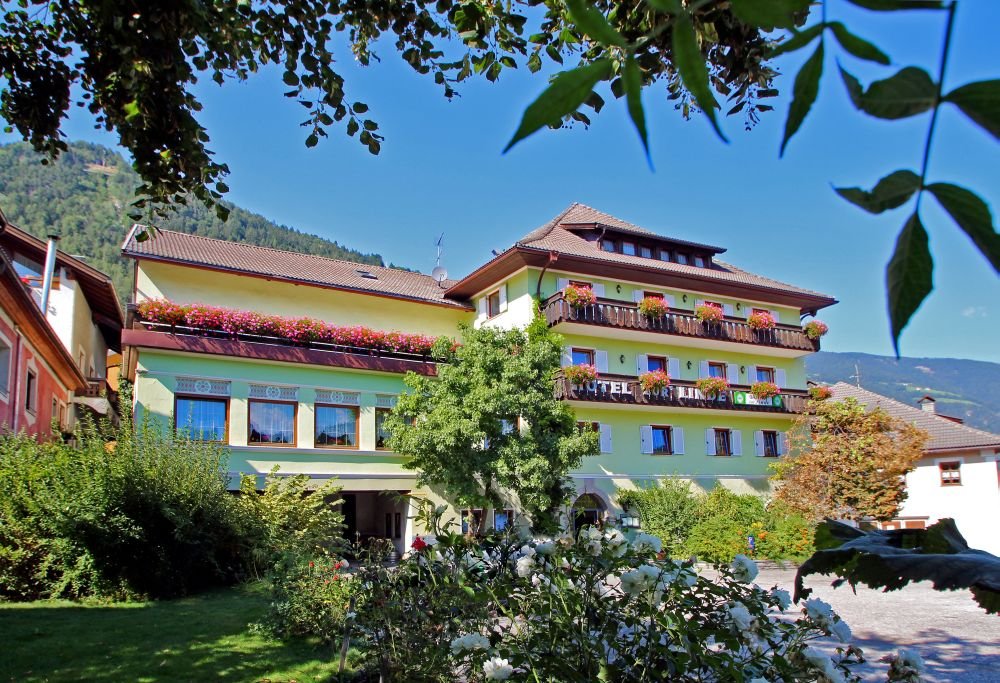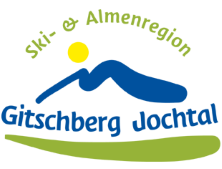The Pfunderer high-altitude trail

In the shade of the much-frequented three-thousand-metre peaks of the Alp’s main ridge in the north and the world-famous Dolomites in the south, the shale and gneiss ridges of the Pfunderer Mountains to this day have remained a lonely and so far little explored area. Although the gigantic views from the Tauern to the Ortler are definitely worth a visit, the summits have so far only rarely been conquered. The untouched landscape, from grainy bedrock, stony high cirques to lushly green and steep flanks, bears witness of a meagre human presence and contributes to the special attraction of these mountains. The Pfunderer alpine trail is a simple trail that allows mountaineers to cross the area within several days and opens a lonely and untouched nature to mountain lovers.
Considering the length of the trail from Sterzing to Bruneck and its situation at altitudes of over 2,000 metres, it was not always possible to resort to existing paths. The marking, a white dot in a red disk, and stone men provide orientation in the partly undeveloped area. Exposed passages could neither be completely avoided, a fact that is particularly visible when traversing the very steep Pfunderer grass slopes. Long distances between the few shelters and simple Alm huts, quickly changing weather conditions with instant fog formation near the central ridge and exposed terrain, make crossing the Pfunderer Mountains a real mountain adventure. Experience, no fear of heights and good physical condition are absolute necessities. In some segments, snow till the end of July as well as from mid-September, cannot be excluded. Valley descents, for instance, in bad weather, are possible within 3 hours maximum and are marked along the way.
The equipment when tackling the mostly unexplored area and the challenging alpine trail that in ideal conditions can be completed with one week should accordingly contain sleeping bag, flashlight, hiking map and compass in addition to the standard protection gear against rain and cold and proper hiking footwear. Telescope sticks come in particularly handy when traversing and at steep descents. Those willing to live on Alm products, can shorten their provisions. The three shelters, Brixner Hütte, Eisbruggjochhütte and Tiefrastenhütte are open from end of June till mid-October, although most sections are still accessible in the stable late autumn, at least as long as snow has not yet fallen. The trail is marked from Sterzing and ends in Bruneck, since the long one-day distance from Bruneck is to be mastered more easily descending. Of course, the trail can also be accessed in the opposite direction.
DAY ONE
The first ascend along tree-covered valley flanks, past larch meadows and Almen leads to a ridge path that crosses the Sengesspitze and thereafter descends to the first over-night stay at the Simile-Mahd-Alm shelter.
From the station in Sterzing, the road takes trekkers in half hour to Wiesen (960 m), where the trail starts again at the entrance of the village next to the Wiesner farm. Those who rather dispense with the ascent and intend to win an hour, can ask to be taken up the asphalted road to the Wendelhof farm. Shortly before the farm, when the road turns left, the Pfunderer alpine trail branches off to the right (sign post). After crossing forests and meadows, hikers reach the ridge near the Gschliessenegg lookout point (1,670 m). Between Pfitscher valley on the left and the view down to the Partinges hamlet in the Eisacktal, the trail continues to the Plitschalm under the Zwölfernock’s slopes. When traversing above the Alm huts, the next descent takes you to the new self-supporter accommodation and emergency shelter without cooking opportunity, but with 8 beds, the Trenser Joch bivouac (2,000 m). At the Jagerjöchl (2,136 m), the trail turns northeast, traverses the south flank of the Höllenkragen and reaches the Trenser Joch (2,212 m), where trekkers are awaited by a couple of old barns (4 hr. from Wiesen). About 100 m after the barns, a short-cut branches off to Simile-Mahd-Alm (Waltersteig, for sure-footed hikers only, 30 min). The original Pfunderer alpine trail crosses the Sengesspitzte (2,268 m) and follows the slightly ascending and widening ridge, until a marking on the right leads trekkers down to the Simile-Mahd-Alm again (2,011 m, 1.5 hr. from Trenser Joch, over-night stay). In the slope above the Alm, trekkers need to watch out for markings, since cow trails can easily mislead them here. Instead of descending to the Simile-Mahd-Alm, the ridge can also be crossed further north towards Sterzinger Hütte (signposts painted on stone), which is, however, only open occasionally. From there, Steig No. 2 leads to the Wilde Kreuzspitze or via the Sandjoch (Mark.17) directly to the Brixner Hütte.
The painful difference in height when descending to the Alm is compensated by the great scenery that the second hiking day entails. From the Simile-Mahd-Alm, you can also descend to Mauls on marked Alm trail No. 2.
DAY TWO
First highlights of the Pfunderer alpine trail today are the Wilder See and Wilde Kreuzspitze, with 3,132 m highest peak of the Pfunderer Mountains.
Two hours after setting out from the Simile-Mahd-Alm, trekkers reach the Sengesjoch (2,620 m) and the harsh landscape with the lake between rocky summits and barren grassland at their feet. In light of the short distance between Simile-Mahd-Alm and Brixner Hütte (approx. 4 hr.), an ascent to Wilde Kreuzspitze should not be missed out on.
Hikers can deposit their backpacks at the Rauhtaljoch (2,800 m), leave the alpine trail and follow marks 18-20 that lead to the summit via a steep, but well passable trail. After one hour, you can reach the south summit with its cross (3,125 m) and enjoy a fantastic panorama view. Also the somewhat higher north summit can easily be reached within a few minutes. After the return to the Rauhtaljoch, the descend takes you through the north side of the Rauhtal, after going around a small glacier on the left (look out for signposts, hidden crevasses!) the flowery meadows of the extended Pfannealm and the Brixner Hütte (2,300 m) soon appear, 3 hr. after leaving the Sengesjoch with summit ascent. The shelter of the South Tyrol Alpine Club’s Brixen section is administered by the Mühlbach council. A descent to Vals (Mark 17) is possible within 2 hr. time. Among the mountains around Brixner Hütte, the Wurmaulspitze (3,022 m) is a particularly recommended destination (2 hr., surefootedness required) as a large part of the Pfunderer alpine trail can be overlooked from its summit.
DAY THREE
The loneliest part of the Nordpfunderer Mountains, where overnight accommodation is scarce.
The 2,610 m high Steinkarscharte marks the transition to the extended valley head of Weitenberg and from the Brixner Hütte can be reached after 45 min. At the pass, trekkers can ascend to the 2,709 m high Pfannespitze via steep grass slopes in about 30 min. A rocky path descends to the Weitenbergalm, however, branches off the Mark 19 trail that leads to Dun and Pfunders, after an about 250-metre descent towards the north. It follows one of the most beautiful sections with view of the mighty mountains of the northern ridge: Grabspitze, Felbe and Rotes Beil and the backdrop-like mountain silhouettes in the east. The Weitenbergkessel can be circumnavigated at an altitude of approx. 2,200 – 2,300 m, before heading towards the mountain range in the northeast, where the Kellerscharte Mountain awaits trekkers. When crossing Weitenberg, hikers are partly left without trails and need to focus on markings and stone men. In 1.5 hr. time (starting from Steinkarscharte) they can, however, reach the 2,439 m high Kellerscharte, which marks the transition to the Engbergtal. From the wide meadows of the Kellerscharte, the view then opens to the Engberg, a rocky, stone-scattered high cirque that is framed by rocky ridges, where lush grasslands, the Engbergalmen, can only be found at the southeast slope. Those who are tired or were surprised by bad weather, can descend to the Alm lodges that are located 300 m down and also stay there over-night. On the next day, you can again reach the alpine trail marking in the valley head. In pursuit of the Pfunderer alpine trail you traverse the valley head between Kellerscharte and Quote at 2,200 m, where the Dannelscharte ascent branches off in the east. Crossing the area above an outcrop, hikers reach a terrace in steeper terrain, where a large stone man can be found. Some metres of descent to the glacier and an almost plain traverse lead to the serpentines towards Dannelscharte (2,437 m). After 1 hr. 15 min. from Kellerscharte, trekkers eventually reach the transition to the Weißsteintal, whose green valley floor is referred to as the Eggerseite by locals. The enormous steep face of the Magersteinwipfel dominates the panorama eastwards. Sharp rock ridges and steep grass slopes below form the valley head in the southeast. The Bodenalm and Dun in Pfunders can be descended to within 1.5 hr. The alpine trail marking branches off from the valley path towards the northern cirque below the Dannelscharte and via an exposed herder’s trail (safety harness recommended) leads below the so called Platte to a turret. From here, one has a great view of the enormous Weißstein high cirque wasteland with its saw-like ridge in the northeast. The Hochwart Mountain (3,045 m) towers above the ridge at its origin. The Gaisscharte, the destination of the next day, is the only ridge transition point. For most mountaineers this distance (5 hr. from Brixner Hütte) might be sufficient, all the more as the duration to the Eisbruggjochhütte amounts to another 4 hours. Overnight accommodation is provided by a bivouac below the trail that can be reached when descending along a waterway before crossing a wooden gate (descent about 150 metres). The bivouac Walther Brenninger am Weißstein (2,150 m) was constructed by volunteers of the Brixen section who transformed old sheep stables in the summer of 1977 and offers room for 8 people.
DAY FOUR
Crossing the Weißstein cirque, traversing Gaisscharte and descending towards Eisbruggsee and Eisbruggjochhütte.
Ascending across steep grasslands, the alpine trail that crosses the high cirque on a partly green ridge can again be accessed after 20 min., before hikers reach a large stone man. Heading towards the Gaisscharte that is visible from far away, a scree passage is to be traversed and after a last steep rock slope, trekkers reach the narrow Gaisscharte (2,700 m), where compact, steep slates rise up along the transition. The eastward descent is very steep and needed to be secured with a wire. After a 40 m descent, hikers reach the Obervals cirque. Another scree passage is to be traversed in the cirque, where even mid-summer snow can often be found, further towards the last ridge before the broad basin of Eisbrugg opens up. This ridge can be circumnavigated in the south and suddenly trekkers arrive high above the dark waters of the Eisbruggsee. When descending to the Eisbruggjochhütte in the northeast, hikers are led down above the lake before heading about 150 m up to the Eisbruggjoch again. The day’s hike of 4 hours leads through partially unmarked terrain, where only stone men and markings provide orientation. The Eisbruggjochhütte of CAI’s Brixen section can also serve as starting point for ascending to the following central ridge summits: Hoher Weißzint (3.371 m), Niederer Weißzint (3.264 m) and Hochfeiler (3.510 m). The short route from Eisbruggjochhütte to the Napfspitze in the south is worth your while at any rate and opens views of the south flanks of above listed three-thousand-metre peaks (1 hr. from the hut).
DAY FIVE
Destination Tiefrastenhütte.
Past the lake, mountaineers follow the Mark 13 trail that via Dun and Pfunders (2.5 hr.) leads to the Eisbruggalm (2,154 m). Here, the Pfunderer alpine trail leaves the cirque floor over a bridge and with serpentines the path reaches the height of the valley’s ridge in the south. At Kuhscharte (2,249 m) a magnificent panorama across the many ridges and cirques of the inner Pfunderertal can be enjoyed and about half the trail’s distance all the way to the mountains around the Hochgrubbachspitze in the southeast can be overlooked. Hikers leave the broad ridge through a wooden gate and descend to an Alm lodge, where a narrow path takes them along the exposed grass slopes and leads into the rocky ravine of the Valzarertbach. At about 1,950 m, they then cross a creek, before again ascending to the meadows of the Gruipa or Grafalm (2,222 m). The rocks of the Schwarze Riffel ruggedly rise as culmination of the ridge (2,742 m) and above the Gruipaalm somewhat closer the Dengelstein (2,698 m). 2.5 hr are required for the segment between Eisbruggjochhütte to Gruipaalm. The trail continues south-eastwards along the steep grass slopes of the mountain ridge without significant differences in height, leading to the Gampesalm under the Passenjoch, where idyllic Alm meadows await hikers. The Gitschschupfen (2,317 m), a group of lodges on the dominating mountain ridge and high above the village of Pfunders, offer particularly extensive views. Once again, the view across the summits and cirques of the inner Pfunderertal, the 3rd and 4th day segments, fascinates. Before reaching the Gampesalm caution is particularly required when taking the narrow path at the steep grass slope in bad weather. The Gampesalm (2,219 m) is a welcome rest stop before ascending to the Passenjoch, an ancient transition between Pfunders and the Mühlwaldertal. The distance between the Gruipaalm and the Passenjoch (2,410 m) can be mastered in 2 hr.
At the Passenjoch cross, the alpine trail turns southwards to a rugged ridge, which is crossed at the Hochsägescharte. Past two lakes hikers then cross rocky terrain under the Hochgrubbachspitze before reaching the Passenjoch. At Hochsägescharte (2,642 m) the view opens into the broad Tiefrasten basin, where the eponymous shelter of the AVS Brixen section is located. The rocky floor of the ridge is dominated by several peaks: Graunock and Kempspitze in the east, Hochgrubbach and Gamsburg in the west. Those who have the time and strength, can side-track to the spectacular Hochgrubbach summit before descending to the Tiefrastenhütte. Not far below the Scharte, the marked trail branches off to the summit that can be reached within 45 min. A rocky path then takes trekkers to the banks of the Tiefrastensee and to the Schutzhaus (2,312 m). A day of rest at one of the nearby summits (particularly worthwhile the 2,738 m high Eidechsspitze, 2.5 hr.) is quite recommended after the long distance of the last day and considering the following, at least equally challenging section. The hiking time from Eisbruggjochhütte to the Tiefrastenhütte amounts to 6.5 hr. The descent from Tiefrasten to Terenten can be mastered in 2 hr.
DAY SIX – LAST TREKKING DAY
From the Tiefrasten cirque to the mountain ridge that between the Mühlwalder and the Pustertal extends from west to east, the last foothills of the Pfunderer Mountains.
Following Mark 23, trekkers descend for about 250 metres towards the valley until a small Alm hut appears, where the alpine trail again turns to the northern slope. At a lush grass ridge, where a source rises, the trail steeply ascends to a small saddle, where a meadow opens that is only bordered in the east by the mountains around the Kleine Tor summit. On a nearly level path along alpine pastures and after a short ascent to the saddle, hikers reach the Kleine Tor (2,374 m), the transition to the Mühlwaldertal after 1.5 hr. The view of the Zillertaler main ridge unfolds and this panorama accompanies trekkers all the way to the Sambock. After 15 min. and traversing at the north slope of the Mutenock, the Dolomites as well appear in the south, from Schlern to Dreischusterspitze. On a high ridge, the alpine trail continues eastwards and traverses several peaks, from Hohe Spitze (2,403 m), Zwölferspitz (2,351 m), Putzenhöhe (2,387 m), Grünseespitze (2,438 m), all the way to the highest point, the Bärentalerspitze (2,450 m, 1.5 hr. from the Kleine Tor). From Grünsee, trekkers can then descend to Issing and Kiens following Mark 65 via Grünbachalm. From Bärentalerspitze, the ridge finally turns southeast and straight to the south to the western Bruggerspitze summit (2,428 m), where the last peak, the Sambock (2,396 m) is reached before descending to the valley. The north access to the Sambock is possible on a good, somewhat exposed trail, partly with climbing passages (30 min. from Bärentalerspitze).
Via level grassland, trekkers then turn towards the south to the cross of the Platte Mountain (2,175 m) and further along alpine rose hedges down to the Geigeralm (1,962 m). A swampy meadow follows, before trekkers are swallowed by the forest, where the path forks off. To the right, following Mark 66a, you can descend to Pfalzen via Platten. Mark 66 leads via the Waidleralm and after traversing a forest road to the Kofler restaurant (1,487 m, 2 hr. from Sambock). The descent from the Kofler to Pfalzen is possible in 45 min. following Mark 17 via Kirchsteig, where a bus waits and takes passengers to Bruneck once per hour. Following Mark 66 trekkers rather steeply descend through the forest in 1 hr. to St. Georgen (half-hourly bus connection to Bruneck). The hiking time on the last day from the Tiefrastenhütte to Pfalzen and/or St. Georgen amounts to 6.5 and/or 7 hr.
A trekking week at altitudes of almost continuously over 2,000 m has come to its conclusion. Not least the simple way of life allows for a rare mountain experience, one that only untouched and lonely areas are able to offer. A salutary contrast, particularly for city slickers.
Walk from Maranza to the Nesselhütte/Gitschberg
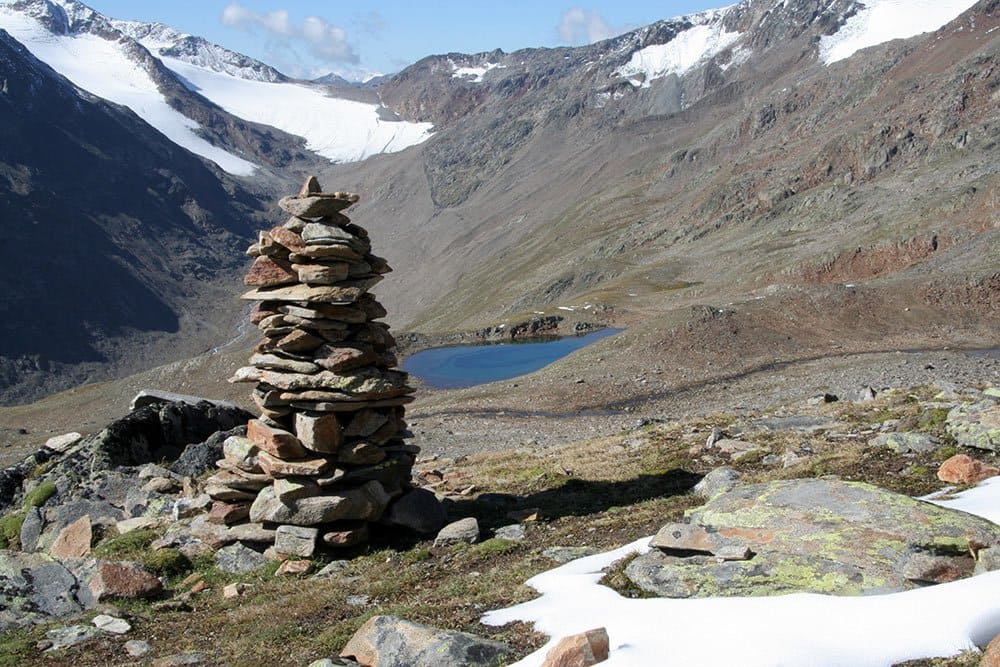
Up to the alpine pastures on the Gitschberg mountain the path proceeds through gentle woods, past lodges and above the timber line, to blooming fields of alpine roses.
Our starting point is the valley station of the Gitschberg funicular at Mittereggen near Maranza (Meransen). Following the marker no. 12 we walk across the meadows towards the forest (the first part is asphalted). Along the wide forest path we carry on higher and higher without any efforts. At 1,900 m asl. the path leaves the forest and we reach the alpine meadows near the Pichlerhütte (mountain hut).
Shortly afterwards we arrive at the Zasslerhütte (mountain hut, 2,050 m asl.), which is located in the valley between the Piccolo Monte Cuzzo (small Gitsch) and the main peak of the Gitschberg mountain. Here we follow the marker no. 21 to the top station of the Gitschberg funicular where our goal is located, the Nesselhütte (2,100 m asl.). The splendid panoramic view ranges from Maranza to the Valle Isarco and the Dolomites. For our way back we take the same route, there are several alternative trails which proceed down through the woods. Of course also the funicular can be used to come back to our starting point again.
Author: AT
Notice: If you want to do this walking tour please take information about the current conditions on site!
Starting point: valley station Gitschberg funicular
Markers: 12, 14, 12, 21
Distance: approx. 6.5 km (each direction)
Walking time: approx. 2.5 h ascent, 1.5 h descent
Altitude difference: approx. 735 m
Altitude level: between 1,390 and 2,110 m asl.
Experienced in: July 2013
video: Big Five in Rio Pusteria
Enjoy with us the Big Five peaks of the ski & holiday area Rio Pusteria from above: Mt. Picco della Croce, Mt. Seefeldspitz, Mt. Cadini, Mt. Cima della Capra (Goat’s Peak) and Mt. Giogo d’Asta.
Mühlbach – Schloss Rodenegg
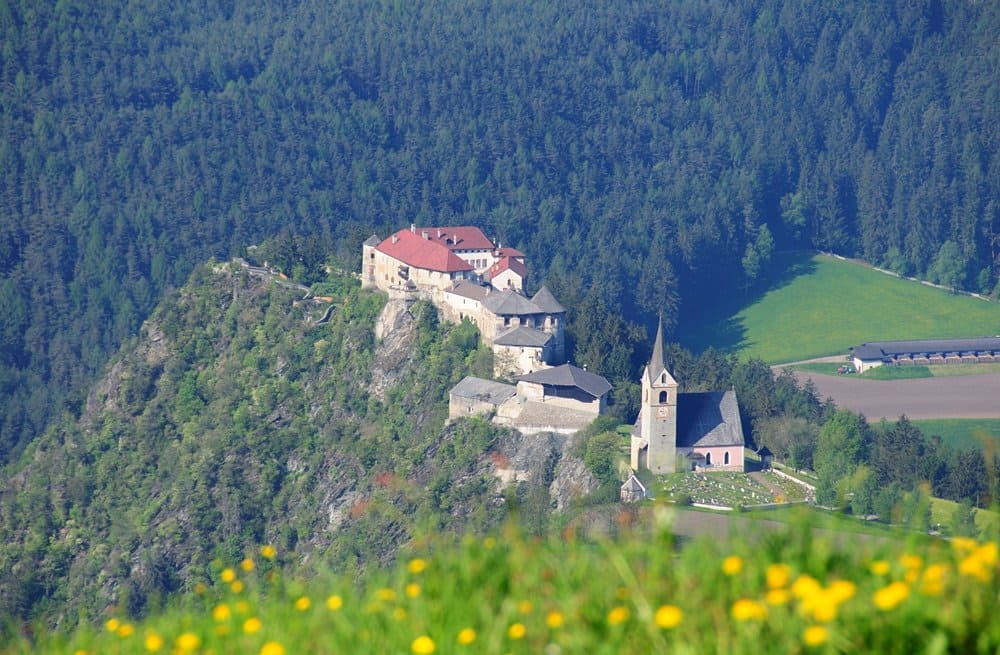
To the Lago del Marmo lake near Valles
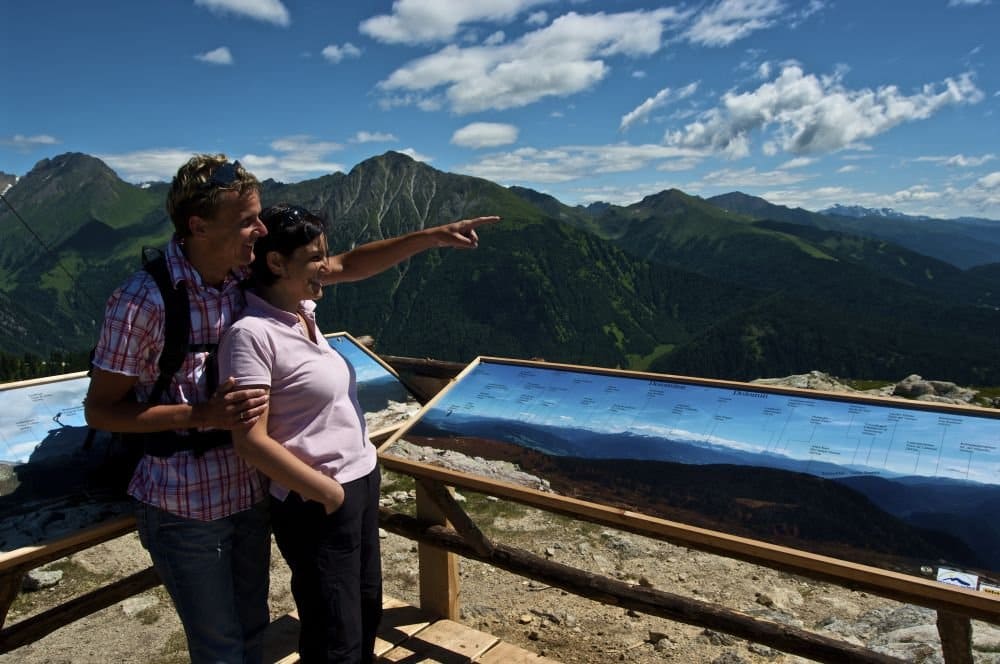
High routes, alpine meadows, a mountain lake, a canyon, landscapes with meadows and woods – all this can be experienced on this mountain hike above the village of Valles. Variety is guaranteed!
By the funicular of Valles we go up to the Jochtal mountain top (2,000 m asl). From here we proceed lightly down to the Passo di Valles/Valler Jöchl (1,930 m asl) and further along the Rotenstein-high route. Past the timber line we walk to the Malga Rotenstein (mountain hut), the path crosses a few scree fields and leads us at the steep hill to the Peachenjöchl (secured). The already autumnally coloured heath combined with the gorgeous view until the Dolomites make us excited about this trail.
Now the path leads downhill to the Malga del Bue (Ochsenalm), then we follow the marker no. 18 towards the Malga Aschila. The path gets really steep now, up to the Malga Aschila and further up to the Lago di Marmo (Marblsee) which is located at 2,400 m asl on a plateau. A small high alpine jewel, the surrounding mountain peaks are reflected in the water. Our next goal is the descent to the Malga Pian di Làbes (mountain hut) which is a popular place to rest in summer. Here the wide path down to the valley starts, we walk through the canyon “Valler Schramme” to the Malga Fane (Fanealm). The well-known “village” of mountain huts offers even three open ones, so we have to stop off. Along the forest path we walk back to Valles where our beautiful tour, which guided us through a variety of landscapes of the Val di Valles, ends.
Author: AT
Notice: If you would like to do this mountain hike please take information about the current conditions on site!
Starting point: Valles, mountain station funicular Jochtal
Markers: 9, 10, Rotenstein Höhenweg (high route), 18, 18A, 17
Experienced in: October 2013
Distance: approx. 16 km (in total)
Walking time: about 5 hours (in total)
Altitude difference: approx. 690 m ascent, 1,300 m descent
Altitude level: between 1,370 and 2,430 asl.
Notice: partly narrow but secured path at the scarp
Altfasstal – Rundwanderung

Tourenverlauf:
Vom Parkplatz am westlichen Rand von Meransen ausgehend führt ein breiter Wanderweg ins Altfasstal. Anfangs durchquert man den Wald, bis sich dann das Tal öffnet und man erblickt eine wunderschöne Landschaft mit blühenden Wiesen und zahlreichen Hütten. Der Weg verläuft bis kurz vor Talschluss. von der Pranter Stadelhütte führt ein Wanderweg kurz aufsteigend zum Jägersteig, welcher durch den Wald auf die Widerschwinge und weiter zum Ausgangspunkt führt.

Hotel zur Linde
Via Katharina Lanz 80
39037 Rio Pusteria (BZ)
Italia


